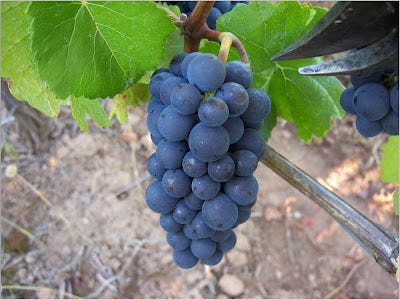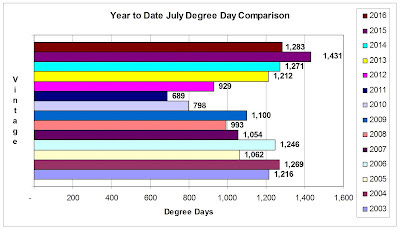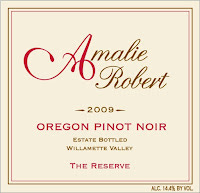Amalie Robert Estate Climate Update: 2016 July-August
Hello and Welcome,
This is the July-August Climate Update from Amalie Robert Estate (a twofer.)
After a whirlwind April, May and June, the months of July and August gave us a much needed respite. From the heat mind you, not the work. The work continued unabated to meet a compressed growing season timetable. The hand work of putting up miles and miles of catch-wires and clipping them into place preceded the tractor mounted hedging work that allows for the hand work of plucking a few leaves to provide perfect sun exposure to our wine, which happens to still be in berry form at this particular moment.

“You don’t have to be crazy to grow Willamette Valley Pinot Noir, but it helps.” - Ernie Pink referring to vintage 2016
As you read this stream of consciousness, the first day of harvest is rapidly approaching. And from the looks of things it will be from the humans not the birds. Although, it is quite assured that they will find their way into a few clusters before the last chapter on this vintage is written. But as Darwin would point out, only the fittest survive. What he did not elaborate upon was his definition of fittest. (At Ernie’s former employer, it was well understood that it was better to be lucky, than good.)
We employ electronic bird callers to attract raptors of all kinds. These bird callers let the local aviary know this is where the action is. It is a common sight during harvest, and the few weeks preceding, to see various and assorted falcons and hawks cruising the vineyard. The fruit eating robins and starlings not so much, but there are daredevils in any species.
Which brings us right up to the fall weather decline of the yellow jacket. These little earth dwelling blighters are not so much of a problem early in the morning when it is cool. But leave a tote bin of wine berries out in the afternoon sun, and it is a whole different ball game. They know their time is coming to an end, and they have no fear. We are ready for them. We have yellow jacket traps baited with salmon fins and skins that we get from our local fish monger. Add a little sunshine and whew, that smells good! They prefer protein over sugar, so we oblige them.
We know what you are thinking: Once you catch a whole mess of yellow jackets how do you prepare them, and more importantly, what wine do you serve?
It may seem as if we meander somewhat aimlessly, unburdened by reality as it were, but to be clear, we meander with a purpose.
The most important thing to remember about harvest, from the human point of view, is that those grapes are not yours until you get them safely into the winery converting sugar into alcohol in a microbially stable and leak proof vessel. Yeah, it’s a long way to the top if you got some grapes to haul…
July and August, while providing some heat spikes, were fairly temperate and provided a downward shift in trajectory from the first half of the growing season. Why it even rained in both July and August! Not as much as Burgundy, of course, and we missed out on the summer hail, which is always nice.
We recorded 0.69 inches of rain for July and 0.36 inches for August for an April to date growing season total of 6.29 inches. Burgundywill average about 2.5 inches of rain in both July and August. Rain during the summer months, and the resulting humidity, can present the winegrower with mildew and bunch rot challenges.
Lackluster canopy management and ill timed rains can add up to acres of compromised fruit. Factor in the fact that we leave more leaves in the fruit zone to provide shade to temper our tannins and canopy management becomes more of a religion than just a good idea.
The last act of farming before harvest is thinning. This is the act of trimming off a portion of the crop. It is done for a variety of reasons including: A) to meet contractual tons per acre requirements, B) to remove excess crop that has no chance of ripening, especially in a cool to cold vintage, and C) to remove whatever you do not want to end up in the fermenter.
Let’s talk about C. We always clip off the wings before harvest. The wing is a fruiting tendril that fruits about a week after the adjacent main cluster and, ergo, ripens after the main cluster. However we have found a home for a portion of these Pinot Meunier and Pinot Noir wings in the Bellpine Pearl Blanc de Noir.


The other thinning targets are short shoots that did not make it to the top of the canopy. Not enough leaves to ripen those clusters, so off they go. Sometimes the vine likes to show off and sport 3 clusters on a singe shoot while all of the other shoots just have 2 clusters. Well, 3 is a crowd and that top cluster will always ripen last, if at all, so off it goes. And sometimes we see a bunch of green berries on a cluster when all of the other clusters have fully turned color. Maybe it didn’t get the memo or just lost track of the days. We have no way of knowing, but we do know that is not something we want in the fermenter. Adios.
Thinning is also a way to influence hang time. Hang time is the time the wine berries need at the end of the season to develop aroma and flavor. The later you thin, the slower the sugars will build and the more hang time you will have. While hang time is generally a good time, you are also developing, or overdeveloping, tannin from the skins. We know we want hang time, but we also know we don’t care for excessive tannins and that is one reason we leave a few extra leaves to keep our Pinot’s elegant. The Syrah, however, is another matter.
And in a vintage like this one we are looking for hang time, but watchful for excessive sugar concentration from desiccation. Desiccation happens when water leaves the wine berry resulting in more concentration of sugar, but not more aroma and flavor development. Desiccation can happen when the vine can’t get enough water from the soil, so it takes it from the wine berry. It can also happen when we experience warm and dry breezes from the east under sunny blue skies. This last condition will also ratchet up tannin (over) development.
As a dry farmed vineyard we don’t pray for miracles, we depend on them. And the miracle we are depending on again this year is a little September rainfall, like in the 1 to 2 inch category. It has happened every year since the warm to hot vintages began in 2012. But like a certain adult recreational activity, you can never really be sure when you are going to get it, how much you are going to get or just how long it is going to last. In fact, premature fermentation appears to be a problem again this year. Not at Amalie Robert Estate of course, but it is out there.
And with that, we will do the numbers.
July is when we started to notice Mother Nature was losing her grip on the throttles. The high temperature for the month was 96.4 and the low temperature was 44.4 degrees Fahrenheit providing a total of 478.05 degree days for July, and a growing season to date total of 1,283. Throw in the sixty-nine hundredths of precipitation and that’s the story, morning glory.

August continued July’s trend, but had a cold snap where Ernie actually built a fire. Ok, it was just a bunch of empty wine boxes, but we still had combustion. The high temperature for the month was 102.4 and the low temperature was 43.4 degrees Fahrenheit providing a total of 538.7 degree days for August, and a growing season to date total of 1,822. Precipitation was 0.36 inches, and is significant in that August is typically dry, Pierre.
So, here we are at the end of August sitting at 1,822 degree days. In retrospect it feels like 2009 where we had an early start to the season, but a moderate summer and cool fall. Or as Ernie recently opined, “It looks like the ass-end is falling out of this vintage.” He’s not really cut out for “prime time.”


If it has been a while, you may want to check out a 2009 Oregon Pinot Noir. That vintage could be coming around again. If you don’t have any, we do. In fact, we have the highest rated 2009 Oregon Pinot Noir - “The Reserve” according to those fine folks over @VinousMedia.
For reference, 2016 ended June with 805 degree days, and was the hottest growing season on record. Now we sit between the 2014 and 2013 vintage. Here are the degree day accumulations through August for the past 4 vintages: 2015: 1,997, 2014: 1,886; 2013: 1,737 and that climatically transitional vintage 2012: 1,474 degree days, which took us from the frigid 2010-2011 vintages to the hotter than Georgia asphalt years. Yowza! What a peach!

And, as we pointed out, there will be September rain, but the when, how much and length of such a tryst is TBD. It will most certainly be a localized event. Your mileage may vary.
Kindest Regards,
Dena & Ernie



